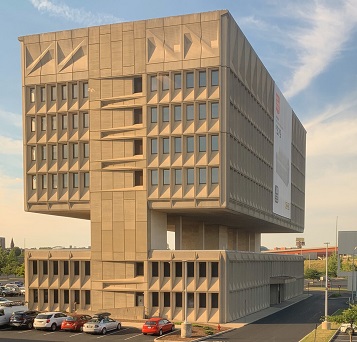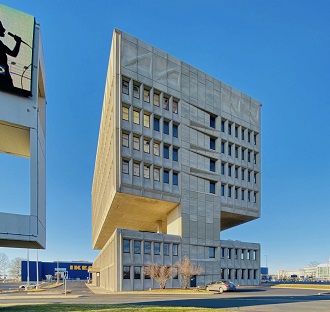 NEW HAVEN, CONN.—When the Hotel Marcel opens next summer in New Haven, Conn., it will be a shining example of sustainability and what every hotel could and should be. The 165-room boutique hotel will be the result of the renovated Armstrong Rubber Company Building, aka Pirelli Building, originally designed by Marcel Breuer in 1967. It will be run by 100 percent solar power, meet net-zero energy standards, and will target LEED Platinum certification. There will be many other bells and whistles that will make the building highly efficient.
NEW HAVEN, CONN.—When the Hotel Marcel opens next summer in New Haven, Conn., it will be a shining example of sustainability and what every hotel could and should be. The 165-room boutique hotel will be the result of the renovated Armstrong Rubber Company Building, aka Pirelli Building, originally designed by Marcel Breuer in 1967. It will be run by 100 percent solar power, meet net-zero energy standards, and will target LEED Platinum certification. There will be many other bells and whistles that will make the building highly efficient.
Hotel Marcel is the project of Bruce Becker, Founder and Director of Becker + Becker, Westport, Conn. Becker purchased the building last year. The building, with its precast façade, has quite the unique look—almost as if a chunk were taken out around the building at the third floor.
Becker was enamored with the Hotel Marcel building for a long time. “I’ve been interested in it because I have a passion for modern architecture,” he says. “It lay vacant for about 20 years.” Unique to the structure is its deep-inset windows. Becker had the windows upgraded to triple-glazed windows—three times more expensive than a normal window would be.
“We got the building on the National Register which qualified it for state and historical tax credits,” Becker says. “That came with a lot of strings attached. “It took more than a year to get the 500-plus windows approved.”
Asbestos Had to Be Removed
Upgrading the envelope of the building has been a major project for Becker. “It had asbestos fireproofing,” he says. “We had to do a careful internal demolition. It cost more than the building itself.” Insulation was added to the walls, ceiling, and roof.
Three parking canopies and the building’s rooftop will be home for the more than 1,000 solar panels. “We will generate and use about 700,000 kilowatt-hours per year,” Becker says. “That is about half of a normal building. We will have about 500 kilowatts of battery storage for emergency backup and for load shifting.”
Hotel Marcel will have an energy recovery system and high-efficiency VRF air-source heat pumps.
“We don’t expect to have an electric bill,” Becker says, adding that Hotel Marcel will use about 20 percent the electricity of a comparable hotel its size. Helping to keep energy consumption down will be LED lighting throughout the building. All lighting will use low-voltage power-over-ethernet (POE) technology.
“We have designed the building with good ventilation,” Becker says. “Every guestroom has 100 percent outdoor air coming into it. Even before LEED I was avoiding millwork with formaldehyde.” Merv13 air filters will be used.
The restaurant will have an all-electric kitchen. “The chefs will be able to produce food more sustainably,” Becker says. “Ventilation hoods will use a lot less energy.”
Plenty of EV Charging Stations
![]() The property will offer electric vehicle charging stations for overnight guests and those who just want to pull off the nearby highway to charge up. Local suppliers are prioritized. The restaurant will do business with local farms.
The property will offer electric vehicle charging stations for overnight guests and those who just want to pull off the nearby highway to charge up. Local suppliers are prioritized. The restaurant will do business with local farms.
For Becker, Hotel Marcel is not his first green development. “My first real dive into sustainability was in the year 2000,” he says. Another one of his LEED projects, for example, is The Octagon, a 500-apartment building on Roosevelt Island in New York City. It was Becker’s first LEED project and was fully leased in the fall of 2006.
For Becker, building “green” just makes plain sense. “It seems like an obvious for a developer,” he says, emphasizing the importance of designing in energy efficiency from the beginning. “You have to live with the results of your design,” he emphasizes. “Most hotels are not built to operate with energy efficiency in mind.”
When designing a building, Becker says he thinks about how it will achieve public objectives. “The process of getting a LEED rating attracts a broad audience,” he says. “Sustainability is a shared objective.” He also mentioned the upside of qualifying for utility incentives, solar tax credits and other incentives.
“It is much easier to finance a building with efficiency built into it,” he says.
From an eventual marketing perspective, Becker says that when it comes time to invite guests in, they will select the hotel because it aligns with their values.
Part of Tapestry Collection by Hilton
 Chesapeake Hospitality will manage the property and helped select the Hilton Tapestry brand for it. “It was important to have a good operator and brand,” Becker says. The LEED Platinum Hotel Skyler in Syracuse, N.Y. is also part of the Tapestry Collection by Hilton.
Chesapeake Hospitality will manage the property and helped select the Hilton Tapestry brand for it. “It was important to have a good operator and brand,” Becker says. The LEED Platinum Hotel Skyler in Syracuse, N.Y. is also part of the Tapestry Collection by Hilton.
Hotel Marcel is slated to be the first Passive House certified hotel in the United States. The program is run by the Passive House Institute US, Inc. (PHIUS). Becker described the certification as a new standard on the cutting edge, simpler than LEED, and focused on the envelope of the building. According to PHIUS, buildings that meet the PHIUS+ standard use 40 to 60 percent less energy for space conditioning than conventional buildings.
Becker believes there should be more hotels in the United States like the Hotel Marcel. “There’s something wrong with the hotel industry,” he says. “There are a lot of hotels in the U.S. and I am all alone doing this and that is shocking for me. It will be a trend moving forward.”
Glenn Hasek can be reached at greenlodgingnews@gmail.com.







Nice hotel..beautifully explained in article. As such Hotel Marcel is not his first green development. Nice one !